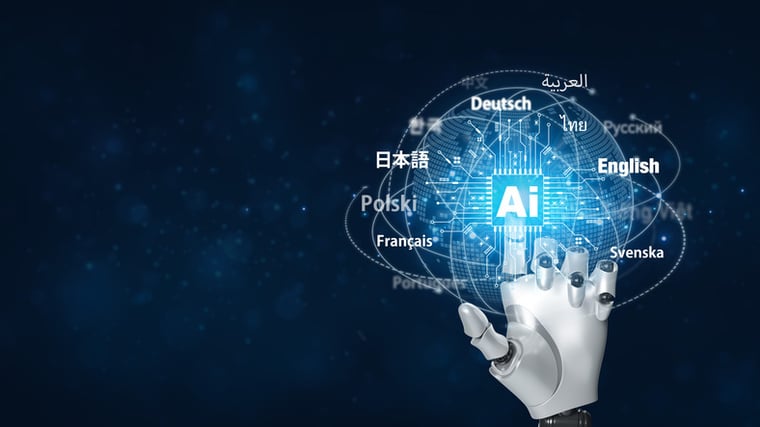The Future of Language Service Providers: Trends to Watch in 2025

Now that we’ve all dipped our toe into 2025, what can we clearly see in our industry that’s going to be a game changer for the rest of the year?
Language services moves at a rapid pace and developments in technology, working practices, and even global politics can influence the way Language Service Providers (LSPs) pivot to give our clients what they’re looking for.
This can be anything from simply better communication to increased speed to market and audience share.
So, what are we seeing that will shape the industry in 2025? Put simply…a lot. As a business engaging with an LSP, what are the high-level trends that you need to be aware of so that you can make the most of your partnership?
Let’s take a look at the top trends for this year, in simple terms, so that with the help of your LSP you can drive your business forward in 2025.
Artificial Intelligence (AI) Integrating With Human Expertise
What industry is AI not on the radar for companies in 2025?
In language services, AI, particularly generative AI and neural machine translation (NMT), has become increasingly sophisticated, offering rapid and cost-effective translation solutions.
But you can’t get around the fact that you still need a human touch for total accuracy. The nuanced understanding and cultural sensitivity provided by human linguists remain indispensable.
So, we’re seeing an increasingly hybrid AI model where AI handles routine tasks, and human experts ensure accuracy, context, and cultural relevance. This collaboration means increased cost efficiency while maintaining high-quality standards.
Multimodal and Multimedia Localization Expansion
With increasing multimedia content, there's a growing demand for localization across various formats, including video, audio, and interactive media.
Again, AI plays a part as advancements in AI-powered tools allows for the seamless integration of text, images, video, and audio localization, making content feel specifically made for different audiences.
Where can we see this trend the most? Industries like marketing, entertainment, and education, where the need for engaging content is what drives audiences to their products and platforms.
Hyper-Localization and Cultural Adaptation
Hyper-localization is a deep dive into a culture. It’s localization taken to another level. Do you always need it? Maybe not. But will taking the time to look at a population in greater detail sometimes be the right thing to do? Absolutely.
Businesses are seeing the importance of tailoring content not just to languages but to specific regional dialects, cultural nuances, and local preferences.
This hyper-localization model involves adapting content to hit at the heart of target audiences, considering local customs, values, and even humor.
It enhances customer engagement and loyalty by providing personalized experiences that reflect the audience's unique cultural context. It makes them feel like a brand really “gets” them.
Data Privacy and Ethical Practices
As AI-driven tools appear everywhere, naturally, data security and ethical use have issues have become more of a concern.
Clients, especially in sensitive sectors like legal, healthcare, and government, demand transparent data practices and the tightest of privacy measures.
The language services industry is working hard to develop on-device AI models that perform computations locally. This increases confidentiality and reduces reliance on centralized servers.
This is always going to be a tough area to keep up with, but it’ll also be one that LSPs will have to work within stringent guidelines if they want to work within sensitive sectors and industries.
Sustainability and Eco-Friendly Practices
The world over sustainability is a growing concern. Consumers want to know that brands and businesses are aware of their environmental impact and how it can be minimized.
They will vote with their feet if they’re just being paid lip service on this front.
A big area of growth is companies increasingly moving towards digital-first workflows to minimize paper usage, utilizing cloud-based platforms to streamline processes, and implementing energy-efficient technologies.
There’s also a growing emphasis on promoting and preserving Indigenous and minority languages, contributing to cultural diversity and inclusion.
Bespoke Machine Translation (MT) Solutions
MT tools are great, but if they’re too generic, their translations are flat, and they defeat their purpose in all but the most mundane translations.
We’re seeing these generic versions giving way to personalized AI models tailored to specific industries, companies, or projects.
This is an area that can really add value to global business. The customized solutions incorporate specialized glossaries, style guides, and user preferences that go much further toward a baseline of consistency and relevance across all languages and even cultures.
This trend is particularly valuable in fields like legal, medical, and marketing, where precise terminology and brand voice are critical.
Voice and Speech Recognition Tech
Natural language processing is advancing at a pace in language services, leading to significant improvements in speech recognition and voice translation technologies.
These tools enable real-time multilingual communication, facilitating seamless interactions in international business settings, customer service, and virtual meetings.
There is a growing need for this speed to continue so that conducting business in another language is as easy as conducting it in your own.
Accessibility and Inclusivity
We’re seeing a greater focus on making content accessible to all, including individuals with disabilities and speakers of minority languages.
This involves providing services like sign language interpretation, real-time captioning, and translation into less commonly spoken languages.
It’s another part of the desire for businesses to reach deeper into their audience and talk to individuals and not just groups.
This move not only complies with regulatory standards but also expands the reach of content to a broader audience, showing the importance of inclusivity to brands.
The Evolution of the LSP Business Model
LSPs are increasingly moving from mere service providers to strategic partners.
There's a shift towards consultative partnerships, where LSPs offer real-world solutions, including linguistic consulting, AI implementation strategies, and cultural expertise.
It goes far beyond just translation and interpretation. It’s about helping clients in working within complex global markets effectively.
Continuous Workflow Integration
Translation workflows are critical to the success of linguistic projects, particularly those that involve large project teams and diverse requirements.
Cloud-based Translation Management Systems (TMS) are being integrated with content management systems, e-commerce platforms, and customer relationship management software.
This integration provides real-time translations, streamlines processes, and ensures consistency across various channels, increasing operational efficiency and giving you better oversight and control, without it becoming a greater draw on your time and resources.
Embrace the Opportunity
It’s an exciting time. 2025 is going to be a mixture of getting the tech right and matching that with making sure you’re speaking to exactly who you want to.
It’s drilling down into your audience and knowing that it’s often the micro-moves (pushing deep into localization) that will make the difference.
Are you feeling that these trends are something that your business can take advantage of? If so, we’d love to talk to you. Consultations are free and there’s no obligation. You’re in safe hands with us as we’re ISO 17100 and ISO 9001 compliant, have over twenty years of professional translation experience, and have earned the trust of organizations around the world.






